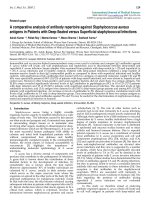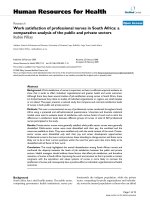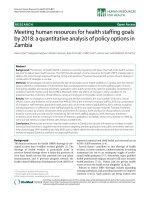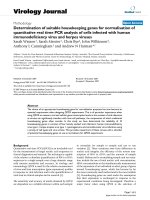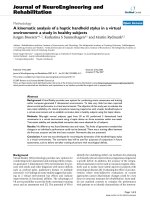A pre-test analysis of ATLAS SBO with RCP seal leakage using MARS code
Bạn đang xem bản rút gọn của tài liệu. Xem và tải ngay bản đầy đủ của tài liệu tại đây (772.63 KB, 8 trang )
Nuclear Science and Technology, Vol.7, No. 4 (2017), pp. 26-33
A pre-test analysis of ATLAS SBO with RCP seal leakage
using MARS code
Quang Huy Pham1, Sang Yong Lee2, Seung Jong Oh2
1
Dalat Nuclear Research Institute, Vietnam Atomic Energy Institute, 01-Nguyen Tu Luc, Dalat city, Vietnam
E-mail:
2
KEPCO International Nuclear Graduate School, 1456-1 Shinam-ri, Seosaeng-myeon, Ulju-gun, Ulsan, Korea
E-mail: ;
(Received 22 November 2017, accepted 29 December 2017)
Abstract: The accident in Fukushima Daiichi nuclear power plants shows the important of developing
coping strategies for extended station blackout (SBO) scenarios of the nuclear power plants (NPPs).
Many NPPs in United State of America are applying FLEX approach as main coping strategies for
extended station blackout (SBO) scenarios. In FLEX strategies, outside water injection to reactor
cooling system (RCS) and steam generators (SGs) is considered as an effective method to remove
residual heat and maintain the inventory of the systems during the accident. This study presents a pretest calculation using MARS code for the Advanced Thermal-hydraulic Test Loop for Accident
Simulation (ATLAS) SBO experiment with RCP seal leakage scenario. In the calculation, the turbinedriven auxiliary feed water pumps (TDAFPs) are firstly used after SBO initiation. Then, the outside
cooling water injection method is used for long term cooling. In order to minimize operator actions
and satisfy requirements of APR1400 emergency operation procedure (EOP), the SGs Atmospheric
Dump Valve (ADV) opening ratio, auxiliary feed water (AFW) and outside cooling water injection
flow rates were investigated to have suitable values. The analysis results would be useful for
performing the experiment to verify the APR 1400 extended SBO optimum mitigation strategy using
outside cooling water injection.
Keywords: Extended SBO, ATLAS, APR1400, RCS, SGs, RCP seal leakage, TDAFP, AFW, outside
water injection.
I. INTRODUCTION
After Fukushima nuclear disaster, the
order No. EA-12-049 was issued by the U.S.
Nuclear Regulatory Commission (NRC) to
require NPPs developing mitigation strategies
in order to cope with beyond-design-basis
external events. Then, FLEX Implementation
Guide (NEI 12-06) was developed by US
Nuclear Energy Institute (NEI) to outline
methods for performing diverse and flexible
mitigation strategies to cope with the scenarios
such as extended loss of AC power (ELAP)
and loss of normal access to the ultimate heat
sink (LUHS) [1]. The main objectives of
FLEX are to provide an approach to deploy
mobile equipment intended to mitigate a
beyond-design-basis external event. In FLEX,
outside cooling water injection into RCS and
steam generators (SGs) is considered as an
effective method to remove residual heat and
maintain the inventory of the systems.
During extended SBO, a loss of offsite
power and alternate current (AC) power could
cause a seal degradation of reactor cooling
pumps (RCP), which eventually causes a loss
of coolant from RCS through RCP seal leakage.
With this scenario, it is worthwhile to examine
the outside cooling water injection for
extended SBO coping strategy by both
calculation and experimental demonstration.
©2017 Vietnam Atomic Energy Society and Vietnam Atomic Energy Institute
QUANG HUY PHAM, SANG YONG LEE, SEUNG JONG OH
Table I. ATLAS major scaling parameters [4]
In this paper, a pre-test calculation using
MARS code for ATLAS extended SBO
experiment with RCP seal leakage is presented.
In the calculation conditions, the onsite and
offsite power (including AAC Diesel
Generators) are not available after SBO
initiated, causing reactor trip, main feedwater
pumps (MFPs) stop running, main steam
isolation valves (MSIVs) and turbine valves
close. Therefore, core and RCS heat removal
relies only on SGs safety relief valves (SRVs)
and TDAFPs. After TDAFPs stop working,
outside cooling water injection is deployed for
long term cooling. In the pre-test calculation,
the SGs ADV opening ratio, AFW and outside
cooling water injection flow rate were
investigated to have suitable values in order to
minimize operator actions and satisfy
requirements of APR1400 EOP.
Scaling
ratio
ATLAS
design
Length
l0R
1/2
Diameter
dOR
1/12
Area
d0R2
Parameters
Volume
lOR dOR
Core temperature
1/144
2
T0R
1/288
1
Velocity
l0R
1/2
1/1.414
Time
l0R1/2
1/1.414
Power/volume
l0R
-1/2
1/2
1.414
Core power
l0R d0R
2
1/203.6
Flow rate
l0R1/2d0R2
1/203.6
l0R
1/2
Pressure drop
III. MARS KS CODE
For the pre-test calculation, the Multidimensional Analysis of Reactor Safety code
(MARS) is used. The code was developed by
Korea Atomic Energy Research Institute
(KAERI). The code’s backbones are the
RELAP5/MOD3.2 and COBRA-TF codes of
USNRC [5]. The first version of MARS was
1.3 released in 1998. In this study, the MARSKS code version 1.3 released in 2007 was used.
The ATLAS input nodalization diagram used
in the pre-test calculation is shown in Fig.1.
II. ATLAS FACILITY AND SCALING
PARAMETERS
The ATLAS is a thermal-hydraulic
integral effect test facility, which was designed
to simulate thermal-hydraulic phenomena of
OPR1000 and APR1400 operational/abnormal
transients [2]. The three-level scaling
methodology developed by Ishii et al. [3] was
applied to design the facility.
The ATLAS primary side has the same
two-loop features, 1/2 on height, 1/288 on
volume, and full pressure simulation in
comparison with APR1400. Due to 1/2-height
model, the time for the event progression of
ATLAS is a squared root 2 times faster than
APR1400. The ATLAS secondary side is
simplified with a circulating loop-type. The
steam from SGs is condensed in a condenser
tank and pumped back into the SGs [4]. The
ATLAS major scaling parameters compared
with APR 1400 are listed in Table I.
IV. CALCULATION RESULTS
A. Steady state calculation
The ATLAS input deck developed by
KAERI is used for the steady state calculation,
in which all important components and thermal
hydraulic parameters of the ATLAS are
described. Since the ATLAS facility is a
scaled-down test facility of APR1400, the
initial and boundary conditions for ATLAS
calculation is based on the scaled-down values
27
A PRE-TEST ANALYSIS OF ATLAS SBO WITH RCP SEAL LEAKAGE USING MARS CODE
of the corresponding conditions of the
APR1400. The steady state conditions of
ATLAS can be archived by running the input
file for a couple of minutes. The ATLAS
calculated steady state conditions in
comparison with the APR1400 are shown in
Table II.
Fig. 1. MARS nodalization diagram of ATLAS.
28
QUANG HUY PHAM, SANG YONG LEE, SEUNG JONG OH
Table II. Steady state conditions of APR1400 and ATLAS
Major
parameter
APR1400
ATLAS
Design
After 5 hours 40 minutes, the station
battery is assumed to be exhausted and
TDAFPs stop working. Then, the maintaining
primary and secondary inventory should be
relied on outside injection sources. The
extended SBO main events from transient
calculation are shown in the Table III.
Atlas
Steady
State
Cal.
Primary system
Power
(MWt)
Pressurizer
pressure
(MPa)
Core inlet
temp. (K)
Core outlet
temp. (K)
3983
1.56
1.56
15.50
15.50
15.55
564.45
563.85
563.80
597.35
597.35
597.30
In the ATLAS transient input file, the
RCPs seal leakage positions were modelled by
the valves located on the discharge pipelines of
4 RCPs. The valve flow area was investigated
in order to get seal leakage flow rate of 0.036
kg/sec/pump at 15.5 MPa, which is
corresponding to 7.3 kg/sec (116.2gpm) in the
RCP technical manual [8]. The Henry-Fauske
choke flow model and default discharge
coefficients in MARS are applied to calculate
the seal leakage flow. In addition, a
conservative 1973 ANS decay heat curve with
a 1.2 multiplication factor is used in the
transient calculation.
Secondary system
SG pressure
(MPa)
Steam temp.
(K)
Feedwater
temp. (K)
Feedwater
flow rate
(kg/sec)
6.90
7.83
7.82
558.05
566.65
565.80
505.35
505.35
505.37
1152.4
0.44
0.44
B. Transient calculation
Table III. Extended SBO main events
The transient calculation conditions of
this study are obtained by scaling down the
corresponding conditions which have been
calculated by J.R. Hwang and S.J. Oh for
APR1400 [6]. During SBO, TDAFPs are very
important to maintain inventory of SGs. The
ATLAS secondary side has no TDAFW trains.
However, the TDAFW behavior can be
simulated by using ATLAS’s feedwater system.
The main assumption regarding installed
equipment is that TDAFPs should be working
until 5 hours 40 minutes after the SBO
initiation (8 hours in APR1400). During that
period, the repetitive ADVs and TDAFW flow
control is not desirable since operators need to
focus on various difficult tasks. Therefore, SGs
ADV opening ratio and AFW flows were
investigated to have a suitable value in order to
minimize operator actions and satisfy
requirements of current APR1400 emergency
operation procedure (EOP) [7].
29
Time
(hh:mm:ss)
Main Event
00:00:00
SBO accident starts, reactor trip,
RCPs coast-down, TD AFPs
supply
feedwater
to
SGs
(0.45kg/sec)
00:02:08
RCP
seal
leakage
starts
(0.036kg/sec/pump at 15.5 MPa)
00:19:07
Reducing AFW flow rate of SGs to
0.07kg/sec (to avoid SG solid
state)
01:03:40
Start
cool-down
and
depressurization
process
by
opening ADV(25% equivalent area
of MSSV)
01:12:50
SITs start injection (set point 4.02
MPa)
05:40:00
TD AFPs stop, full opening of
ADV
Start outside water injection to
RCS and SGs.
12:00:00
End of calculation
A PRE-TEST ANALYSIS OF ATLAS SBO WITH RCP SEAL LEAKAGE USING MARS CODE
the water level is still kept above top of fuels
before SITs injection. The core residual heat
is mainly removed via secondary side by
natural circulation and depressurization
process. The calculation results for core
collapsed level and cladding temperature are
shown in Fig.4.
0.03
3.6
350
3.4
0.02
Core level (m)
Mass flow rate (kg/sec)
0.04
0.01
300
Core level
Fuel Cladding Temp.
3.2
3.0
250
2.8
200
2.6
2.4
150
0.00
0
2
4
6
8
10
2.2
12
Time (hr)
2.0
100
0
Pressure (MPa)
14
Primary
Secondary
10
8
6
4
2
0
4
6
8
10
8
10
12
For the SG inventory, operators
should control the TDAFP flows at about 20
minutes to avoid solid state of SGs, and the
cool down procedure was started after 1
hour 4 minutes of SBO. The cool down rate
using secondary side depends on the SGs
water
level,
main
steam
pressure,
temperature and RCS cool down rate. In this
case, one ADV opening area of each train
was investigated to be 25% equivalent area
of main steam safety valve (MSSV) for cool
down and the TDAFP flow rate is set to
0.072 kg/sec to each SG. With this flow rate,
SG inventory is maintained above 27% wide
range level without any additional flow
control by operators. This SG inventory
condition during depressurization process is
satisfied the current APR 1400 EOP for SG
inventory of wide range operation from 25%
to 88% [7]. Fig.5 shows the behavior of SG
levels during the transient calculation.
16
2
6
Fig. 4. Core collapsed level and fuel cladding
temperature
Primary pressure starts decreasing after
reactor trip and RCP seal leakage initiation.
Meanwhile, SGs inventory is maintained by
TDAFPs. The SGs MSSVs are cycling
open/close to release pressure from SGs
before cool-down process is performed.
Primary and secondary pressure behaviors are
shown in Fig. 3.
0
4
Time (hr)
Fig. 2. RCP seal leakage flow rate (1RCP)
12
2
12
Time (hr)
Fig. 3. Primary and secondary pressure
The core water level is gradually
decreased due to RCP seal leakage. However,
30
Fuel Cladding Temp. (oC)
The transient calculation starts with
SBO event, the RCP seal leakage is initiated at
128 seconds after SBO initiation (3 minutes in
APR1400). The RCP seal leakage flow rate is
shown in Fig.2.
QUANG HUY PHAM, SANG YONG LEE, SEUNG JONG OH
could affect the RCS inventory recovery process
subsequently. Therefore, in the pre-test
calculation, the SIT isolation level is assumed to
be before the SIT levels drop down to the
emptied level of about 2.6m [4], corresponding
with fluidic device bottom levels.
In the calculation, some oscillations of
the SIT discharge flow during the injection
time as shown in the Fig.6. Probably, the
interfacial heat transfer in the downcomer area
is oscillated when the SIT discharge flow
injected to the downcomer. Then, downcomer
pressure will be oscillated, causing some
oscillations
of
SIT
discharge
flow,
subsequently. The other reason for the SIT
discharge flow oscillation could cause by the
numerical problems in simulation. In addition,
a very small negative flow was appeared from
SIT discharge flow calculation, probably
caused by condensation phenomena in SIT
discharge pipe. These issues need to be
investigated and improved in further study.
Fig. 5. SGs water level
During the first phase of SBO, the SIT
injection flow rates are very important. The
behavior of RCS will vary depending on RCP
seal leakage, SIT injection time and flow rates.
In the APR1400, each of the four SITs equipped
a fluidic device which is used for passively
controlling the injection flow rate from SIT to
RCS. The fluidic device changes injection flow
condition from high flow to low flow condition
during injection time of the SITs. In the ATLAS
SITs, the fluidic device was not equipped as
those in APR 1400. The high flow injection
condition from ATLAS SITs was simulated by
using orifices with an optimized flow area to
throttle the SIT discharge line. The low flow
injection condition was achieved by changing
the opening area of the valves in the SIT
injection line [4].
The SITs isolation is performed at 3
hours 51 minutes before the SIT levels drop
down to the emptied levels. Fig.7 shows the
SITs accumulated injection mass. When the
SITs are isolated, the total amount of water
injected to RCS of each SIT was about 180 kg.
So far, there is no specific conditions in
the current APR 1400 EOP [7] for SIT isolation
could be satisfied in case of extended SBO with
RCP seal leakage, or extended SBO with
combined accidents such as LOCA, SG U tube
ruptures etc. The current APR 1400 SBO EOP
is mainly focusing on restoring power sources
and using the installed equipment of the plant to
maintain and perform the key safety functions.
Since the lately SIT isolation could cause
injection of the noncondensable gas (i.e.
Nitrogen) to RCS, and the early SIT isolation
Fig. 6. SITs injection flow rates
31
A PRE-TEST ANALYSIS OF ATLAS SBO WITH RCP SEAL LEAKAGE USING MARS CODE
outside injection flow rates as shown above,
the inventory of RCS and SGs are maintained
until 12 hours without any injection flow
adjustment performed by operators.
Fig. 7. SITs accumulated injection mass
At 5 hours 40 minutes, the pre-test
calculated results for SG pressure and
temperature were 0.63 MPa and 162oC,
respectively. The steam line pressure is shown
in Fig. 8. These conditions are satisfied the
TDAFP operation conditions (>0.48 MPa and
157oC) [7].
Fig. 9. Outside injection flow rate to RCS
Fig. 10. Outside injection flow rate to SG
III. CONCLUSIONS
The pre-test calculation for ATLAS
extended SBO with RCP seal leakage and
outside cooling water injection scenario is
performed. From the calculation results,
outside cooling water injection into RCS and
SGs is verified as an effective method during
extended SBO when RCS and SGs
depressurization is sufficiently performed. The
SGs ADV opening ratio, AFW and outside
cooling water injection flow rates were
investigated in order to minimize operator
Fig. 8. Steam line pressure
After 5 hours 40 minutes, outside water
injection starts for long term cooling. Fig.9
and Fig.10 show the outside injection flow
curves from the external pumps to the RCS and
SGs depend on the system pressures. The
external pumps in the pre-test calculation were
selected to be A-l fire trucks, which are widely
used in fire stations in Korea with discharge
pressure more than 14 kg/cm2 [9]. With the
32
QUANG HUY PHAM, SANG YONG LEE, SEUNG JONG OH
[5] KAERI, MARS code manual, KAERI/TR2812/2004, 2009.
actions and satisfy requirements of current
APR1400 EOP. The pre-test calculation is
expected to be useful for conducting the
experiment in future to produce the optimal
emergency operation and mitigation strategy
for APR 1400 to cope with the extended SBO
accident scenarios.
[6] J.R. Hwang, S.J. Oh, “Developing Optimal
Procedure of Emergency Outside Cooling Water
Injection for APR1400 Extended SBO Scenario
Using MARS Code,” KNS, 2013.
[7] Korea Hydro & Nuclear Power Co., Ltd., ShinKori Unit 3,4 NPP, “Station Blackout
Emergency Operation Procedure, EOP-07, Rev.
0, 2011.
REFERENCES
[1] NEI 12-06, “Diverse and Flexible Coping
Strategies (FLEX) Implementation Guide,” Rev.
0, 2012.
[8] Westinghouse Electric Company LLC, “Reactor
Coolant Pump Type R01 Technical Manual,”
Volume 1, 9-181 -Z-431 -N01C, 2011.
[2] Y. S. Kim et al, “Commissioning of the ATLAS
Thermal Hydraulic Integral Test Facility,”
Annals of Nuclear Energy, 35, 1791, 2008.
[9] J.R. Hwang, “Use of Emergency Outside
Cooling Water Injection for APR1400 Extended
SBO Scenario,” Master thesis, Kepco
International
Nuclear
Graduate
School
(KINGS), 2013.
[3] M. Ishii, et al., “The three level scaling approach
with application to the Purdue University multidimensional integral test assembly (PUMA),”
Nuclear Engineering and Design, 186, 177–211,
1998.
[4] K.H. Kang, et al., “Detailed Description Report
of ATLAS Facility and Instrumentation,”
KAERI/TR-4316/2011, Korea Atomic Energy
Research Institute, 2011.
33
